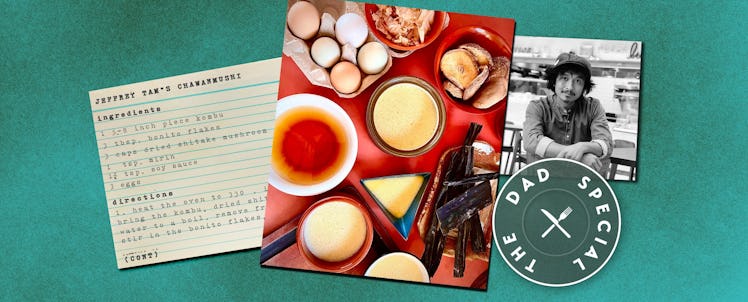This Savory, Simple Japanese Chawanmushi Recipe Is Perfect for Kids
Courtesy of Chef Jeffrey Tam, the popular savory custard is nourishing, easy to prepare, and endlessly adaptable.

Chef Jeffrey Tam remembers sitting in the kitchen with his grandmother as she transformed eggs into a savory custard known as water egg, in China, chawanmushi, in Japan, or gyeranjjim, in Korea. She’d whisk eggs with broth, strain the mixture into small crocks, and bake it in the oven or steam on the stovetop. The resulting dish was warm and soft just-set custard. She’d top it with a sprinkling of sliced scallions. Tam’s mother made a similar version of the recipe, too. She included mushrooms and chicken.
“It’s simple, delicious, and has deep roots,” says Tam who is the founder of the seafood market Pesce Lulu at The Hugh in New York. “It’s very cleansing and comforting while still being healthy.”
Cooking together is a big part of the Tam family, and he enjoys instructing his daughters in the kitchen. (“Teaching my children how to cook is like teaching them how to live,” he says.) His home menu is full of healthy staples, especially soups prepared with halibut-bone- and other umami-packed broths.
But when asked to share a recipe with Fatherly, Tam immediately suggested chawanmushi. He continues the tradition his grandmother began, regularly preparing the dish for his family and friends. “It’s something that we love to make together on the weekends,” he says.
The basic structure of chawanmushi, which translates to “steamed in a bowl” and is often served as an appetizer, is that whisked eggs are combined with a rich dashi and such seasonings as soy sauce and mirin. The mixture is then strained into individual heatproof bowls, crocks, or cups, which are then placed in a casserole dish with boiling water. The mixture is steam-baked until solid but still creamy and traditionally served with a variety of toppings including scallion, shitake mushrooms, and shiso.
Chawanmushi is quite easy to prepare, requiring only a few ingredients. Flavor and personality can be added by tweaking the type of broth, toppings, and seasonings. In addition to the simplicity of the dish, Tam loves its customizability.
“I’ve adopted and made it casually or for a special occasion with many different variations: Seafood, fish broth, seaweed broth, shiitake broth, topped with ikura, dried bonito, hazelnut oil, sesame oil, truffle oil, and even fresh truffles,” he says.
Tam adds that every culture, family, and person has a unique spin on the dish, so the possibilities are really endless.
“You can add any ingredient to make it your own,” he says. “If you want Mexican flavors, add salsa. If you want it to be super decadent, add truffles. The flavors and ingredients you add will help make it feel uniquely yours.”
If you’re new to chawanmushi, try a base recipe before you start riffing. Here, courtesy of Chef Tam is his version, which can be made in under an hour.
Chef Jeffrey Tam’s Chawanmushi/Gyeranjjim Recipe
Yield: serves 4
Time: 40 minutes
Tools
- Small sauce pan
- Fine sieve
- Medium bowl
- Whisk
- 6-8 oz. ramekins or small bowls
Ingredients
- 1 (5-8 inch) piece kombu
- 3 tbsp. bonito flakes
- 3 caps dried shitake mushroom
- 1 tsp. mirin
- 1 1⁄4 tsp. soy sauce
- 3 large eggs
Instructions
- Heat the oven to 330 degrees. In a small saucepan, bring the kombu, dried shitake, and 1 1⁄2 cups of water to a boil. Remove from the heat, remove and discard the kombu, stir in the bonito flakes, and let stand for 5-10 minutes. Pour the dashi through a fine sieve into a bowl and let cool. (This can also be cold-brewed together overnight in the fridge for maximum flavor)
- In a separate bowl, add the dashi, mirin, soy sauce, and eggs and whisk. Divide the custard among four 6-8oz. ramekins or small bowls, and set inside a 9-by-13-inch baking dish and set the baking dish in the oven. Pour enough boiling water into the baking dish to come halfway up the sides of the ramekins and bake the custards until set but still slightly loose in the center, about 30 minutes. Allow the chawanmushi to cool slightly before serving.
This article was originally published on